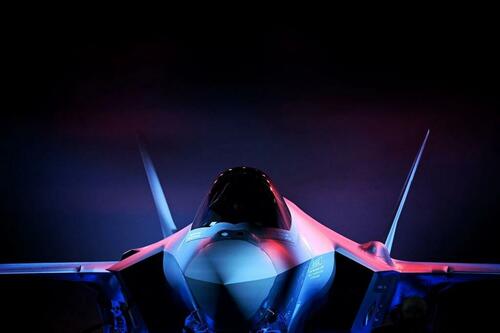F-35’s Cooling Crisis: Design Flaws Fuel $2 Trillion Dilemma For Pentagon
Authored by Mike Fredenburg via The Epoch Times,
The Pentagon is facing a difficult decision regarding the F-35’s chronic, crippling problems with overheating brought on by its insufficient cooling capacity.
Should the U.S. taxpayers pay for a costly upgrade to the stealth fighter’s cooling that will handle its immediate needs, or should U.S. taxpayers pay for a far more expensive upgrade that theoretically could handle increased future cooling needs?
Before we briefly address the two options facing the Pentagon, let’s look at why cooling capacity is so important for the F-35 and why the most expensive weapons system program in world history produced a plane that was destined to have inadequate cooling from the very beginning.
Having adequate cooling is vital because a fighter’s avionics, radar, and other electronics-based systems generate heat. While air cooling is always part of the cooling solution, modern fighters cram so much heat-producing electronics into a relatively small space that air cooling alone is insufficient.
Various types of liquid cooling are necessary, especially for power-hungry radars. This is particularly true of the F-35, which is advertised as a flying supercomputer crammed full of heat-producing computers, communications, and avionics equipment. When it comes to heat production, its powerful AN/APG-81 AESA radar leads the way.
The bottom line is that it takes a whole bunch of electronics to produce a whole bunch of heat to give the F-35 its much-touted capabilities and make it the world’s preeminent fighter.
Regardless of the validity of the claims to preeminence, there is zero doubt that the F-35’s designers designed a fighter that, from the outset, had insufficient cooling. This nearly intractable problem has been exacerbated as new capabilities are added, requiring more computing power and generating more heat. In particular, the group of new Block IV capabilities that we are told are necessary for the F-35 to fulfill its long overdue promise of being a dominant fifth-generation fighter will require a whole bunch more cooling.
The underlying issue powering the cooling crisis is that the F-35 design team only designed the F-35 with 14 kilowatts (kW) of cooling power. Yet the F-35 was not declared fully operational until Block 3F capabilities were incorporated—capabilities that required roughly 32 kW of cooling and have only recently been rolled out, some 30 years after development began on the F-35 Joint Strike Fighter. The Block 3F upgrade necessitated modifying the F-35’s cooling system. It negatively impacted the longevity and reliability of the F-35’s F135 engine, which was already struggling with reliability issues.
So why was the F-35’s cooling capacity initially so under-specced?
The answer to this question is also the answer to most of the problems that have plagued a plane that came out of a design-by-committee process—a process that took what was supposed to be a low-cost, relatively lightweight replacement for the F-16 and the F/A-18 A and C Hornet that would complement bigger, more expensive fighters like the F-22 and the Navy’s F/A-18E/F Super Hornet.
Ultimately, what was supposed to be a relatively low-cost, lighter complement to large twin-engined fighters like the F-22 and F/A-18E/F became a single-engine fighter heavier than many twin-engined fighters.
The massive weight of the F-35 meant that Pratt & Whitney had to design an engine with a far higher power-to-weight ratio than the F-22’s still cutting-edge F119 engine. It also meant that the F-35 had to undergo a draconic weight reduction program where every ounce mattered. Pratt & Whitney succeeded in getting the power by ramping up the operating temperature far beyond what had ever been done for a production fighter engine.
Still, as time has proven, the massive increase in turbine inlet temperature to an insane 3,600 degrees Fahrenheit—900 to 1,100 degrees more than most other jet fighter engines—ensured that the engine would suffer from reliability and longevity issues. The fact that engine power is required for cooling only exacerbated the problem as power requirements for each F-35 capability upgrade added the need for more cooling, which meant the F-35 engine was subjected to more stress.
That this would be the case had to be understood by the F-35 design team, but they also understood that without the massive increase in engine power only possible by pushing the F-35 engine operating temperature far into bleeding edge territory, the F-35 program was dead in the water and that adding any weight for anything would also seriously jeopardize the program.
Consequently, the decision to under-spec the F-35 cooling capacity happened because incorporating enough cooling capacity into the F-35’s design to allow for reasonable growth would have added weight that would have reduced the range and payload of all the F-35 variants, but in particular, the Marine’s VTOL capable F-35 where any additional weight threatened to lower its range and payload combination below minimum acceptable performance parameters.
If truth be told, the capabilities crammed into the F-35 would have made sense for a two-engine design. However, changing the F-35 to a twin-engine design was a no-go because it would have immediately dispelled the illusion that the F-35 was going to be a low-cost replacement for the F-16. Just as importantly, there was no twin-engine vertical and take-off landing (VTOL) F-35 design for the Marine Corps.
So, in the end, the F-35 was released with an engine destined to be unreliable with a cooling capacity that no experienced aerospace engineer could have credibly claimed would meet future cooling needs.
This brings us back to the question of whether it makes sense to go with an expensive short-term solution or a costly longer-term cooling solution. From a sales perspective, this is a choice of two positives that the Pentagon would like us to focus on. But before committing to the options being presented, let’s consider that the current F-35 engines are wearing out faster than promised. The engine control units that will supposedly make them reliable are not due to have their design completed until 2029.
Also, consider that the program cost, including sustainment, is now projected to be over $2 trillion, 400 percent more in inflation-adjusted dollars than its 2007 GAO estimate. Further, as has happened so many times before, the cost estimate could grow once again.
Finally, there is no guarantee that the desperately needed engine core upgrade from Pratt & Whitney, which is supposed to be delivered in 2029, will be delivered on time or that it will actually make the F-35 engine reliable.
Consequently, given that the level of risk and costs for the F-35 program only seems to be growing, maybe we should think of a creative way to get our existing F-35s flying with some reasonable level of reliability. Before building new F-35s, a carefully chosen set of hardware and software capabilities that do not require increases in power and cooling should be considered.
Doing this would be a significant achievement!
Views expressed in this article are opinions of the author and do not necessarily reflect the views of The Epoch Times or ZeroHedge.
Tyler Durden Sat, 11/23/2024 – 15:10
Source: https://freedombunker.com/2024/11/23/f-35s-cooling-crisis-design-flaws-fuel-2-trillion-dilemma-for-pentagon/
Anyone can join.
Anyone can contribute.
Anyone can become informed about their world.
"United We Stand" Click Here To Create Your Personal Citizen Journalist Account Today, Be Sure To Invite Your Friends.
Before It’s News® is a community of individuals who report on what’s going on around them, from all around the world. Anyone can join. Anyone can contribute. Anyone can become informed about their world. "United We Stand" Click Here To Create Your Personal Citizen Journalist Account Today, Be Sure To Invite Your Friends.
LION'S MANE PRODUCT
Try Our Lion’s Mane WHOLE MIND Nootropic Blend 60 Capsules
Mushrooms are having a moment. One fabulous fungus in particular, lion’s mane, may help improve memory, depression and anxiety symptoms. They are also an excellent source of nutrients that show promise as a therapy for dementia, and other neurodegenerative diseases. If you’re living with anxiety or depression, you may be curious about all the therapy options out there — including the natural ones.Our Lion’s Mane WHOLE MIND Nootropic Blend has been formulated to utilize the potency of Lion’s mane but also include the benefits of four other Highly Beneficial Mushrooms. Synergistically, they work together to Build your health through improving cognitive function and immunity regardless of your age. Our Nootropic not only improves your Cognitive Function and Activates your Immune System, but it benefits growth of Essential Gut Flora, further enhancing your Vitality.
Our Formula includes: Lion’s Mane Mushrooms which Increase Brain Power through nerve growth, lessen anxiety, reduce depression, and improve concentration. Its an excellent adaptogen, promotes sleep and improves immunity. Shiitake Mushrooms which Fight cancer cells and infectious disease, boost the immune system, promotes brain function, and serves as a source of B vitamins. Maitake Mushrooms which regulate blood sugar levels of diabetics, reduce hypertension and boosts the immune system. Reishi Mushrooms which Fight inflammation, liver disease, fatigue, tumor growth and cancer. They Improve skin disorders and soothes digestive problems, stomach ulcers and leaky gut syndrome. Chaga Mushrooms which have anti-aging effects, boost immune function, improve stamina and athletic performance, even act as a natural aphrodisiac, fighting diabetes and improving liver function. Try Our Lion’s Mane WHOLE MIND Nootropic Blend 60 Capsules Today. Be 100% Satisfied or Receive a Full Money Back Guarantee. Order Yours Today by Following This Link.







